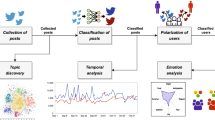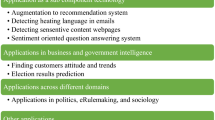Abstract
The ever-growing number of people using Twitter makes it a valuable source of timely information. However, detecting events in Twitter is a difficult task, because tweets that report interesting events are overwhelmed by a large volume of tweets on unrelated topics. Existing methods focus on the textual content of tweets and ignore the social aspect of Twitter. In this paper, we propose mention-anomaly-based event detection (MABED), a novel statistical method that relies solely on tweets and leverages the creation frequency of dynamic links (i.e., mentions) that users insert in tweets to detect significant events and estimate the magnitude of their impact over the crowd. MABED also differs from the literature in that it dynamically estimates the period of time during which each event is discussed, rather than assuming a predefined fixed duration for all events. The experiments we conducted on both English and French Twitter data show that the mention-anomaly-based approach leads to more accurate event detection and improved robustness in presence of noisy Twitter content. Qualitatively speaking, we find that MABED helps with the interpretation of detected events by providing clear textual descriptions and precise temporal descriptions. We also show how MABED can help understanding users’ interest. Furthermore, we describe three visualizations designed to favor an efficient exploration of the detected events.













Similar content being viewed by others
Notes
References
Aggarwal CC, Subbian K (2012) Event detection in social streams. In: SDM, pp 624–635
Aiello LM, Petkos G, Martin C, Corney D, Papadopoulos S, Skraba R, Goker A, Kompatsiaris Y, Jaimes A (2013) Sensing trending topics in twitter. IEEE Trans Multimed 15(6):1–15
AlSumait L, Barbará D, Domeniconi C (2008) On-line lda: adaptive topic models for mining text streams with applications to topic detection and tracking. In: ICDM, pp 3–12
Becker H, Iter D, Naaman M, Gravano L (2011) Beyond trending topics: real-world event identification on twitter. In: ICWSM, pp 438–441
Benhardus J, Kalita J (2013) Streaming trend detection in twitter. IJWBC 9(1):122–139
Bentley J (1984) Programming pearls: algorithm design techniques. CACM 27(9):865–873
Bernstein MS, Suh B, Hong L, Chen J, Kairam S, Chi EH (2010) Eddi: interactive topic-based browsing of social status streams. In: UIST ’10, pp 303–312
Blei D, Ng A, Jordan M (2003) Latent dirichlet allocation. JMLR 3:993–1022
Blondel V, Guillaume JL, Lambiotte R, Lefebvre E (2008) Fast unfolding of communities in large networks. J Stat Mech: Theory Exp P10008:1–12
Erdem O, Ceyhan E, Varli Y (2012) A new correlation coefficient for bivariate time-series data. In: MAF, pp 58–73
Fan TH, Lee S, Lu HI, Tsou TS, Wang TC, Yao A (2003) An optimal algorithm for maximum-sum segment and its application in bioinformatics. In: CIAA, pp 251–257
Fung GPC, Yu JX, Yu PS, Lu H (2005) Parameter free bursty events detection in text streams. In: VLDB, pp 181–192
Guille A, Favre C, Hacid H, Zighed D (2013) Sondy: an open source platform for social dynamics mining and analysis. In: SIGMOD, pp 1005–1008
Haynes J, Perisic I (2010) Mapping search relevance to social networks. In: SNA-KDD, pp 11–20
Hopcroft J, Tarjan R (1973) Algorithm 447: efficient algorithms for graph manipulation. CACM 16(6):372–378
Humphries M, Gurney K, Prescott T (2006) The brainstem reticular formation is a small-world, not scale-free, network. Biol Sci 273:503–511
Kim YH, Seo S, Ha YH, Lim S, Yoon Y (2013) Two applications of clustering techniques to twitter: community detection and issue extraction. Discret Dyn Nat Soc 2013:1–9
Kleinberg J (2002) Bursty and hierarchical structure in streams. In: KDD, pp 91–101
Kraft T, Wang D, Delawder J, Dou W, Li Y, Ribarsky W (2013) Less after-the-fact: investigative visual analysis of events from streaming twitter. In: LDAV, pp 95–103
Kwak H, Lee C, Park H, Moon S (2010) What is Twitter, a social network or a news media? In: WWW, pp 591–600
Landis JR, Koch GG (1977) The measurement of observer agreement for categorical data. Biometrics, pp 159–174
Lappas T, Arai B, Platakis M, Kotsakos D, Gunopulos D (2009) On burstiness-aware search for document sequences. In: KDD, pp 477–486
Lau JH, Collier N, Baldwin T (2012) On-line trend analysis with topic models: #twitter trends detection topic model online. In: COLING, pp 1519–1534
Lee P, Lakshmanan LV, Milios E (2013) Keysee: supporting keyword search on evolving events in social streams. In: KDD ’13, pp 1478–1481
Li C, Sun A, Datta A (2012) Twevent: segment-based event detection from tweets. In: CIKM, pp 155–164
Marcus A, Bernstein MS, Badar O, Karger DR, Madden S, Miller RC (2011) Twitinfo: aggregating and visualizing microblogs for event exploration. In: CHI ’11, pp 227–236
Mathioudakis M, Koudas N (2010) Twittermonitor: trend detection over the twitter stream. In: SIGMOD, pp 1155–1158
McMinn AJ, Moshfeghi Y, Jose JM (2013) Building a large-scale corpus for evaluating event detection on twitter. In: CIKM, pp 409–418
Newman MEJ (2006) Modularity and community structure in networks. Proc Natl Acad Sci USA 103(23):8577–8582
Oxford UP (2009) OUP dictionary team monitors twitterer and tweets. http://blog.oup.com/2009/06/oxford-twitter/
Parikh R, Karlapalem K (2013) Et: events from tweets. In: WWW (companion volume), pp 613–620
PearAnalytics (2009) Twitter study. Tech. rep., http://www.pearanalytics.com/wp-content/uploads/2012/12/Twitter-Study-August-2009.pdf
Romero D, Chenhao T, Ugander J (2013) On the interplay between social and topical structure. In: ICWSM, pp 516–525
Romero DM, Meeder B, Kleinberg J (2011) Differences in the mechanics of information diffusion across topics: idioms, political hashtags, and complex contagion on twitter. In: WWW, pp 695–704
Shamma DA, Kennedy L, Churchill EF (2011) Peaks and persistence: modeling the shape of microblog conversations. In: CSCW, pp 355–358
Valkanas G, Gunopulos D (2013) How the live web feels about events. In: CIKM, pp 639–648
Weng J, Lee BS (2011) Event detection in twitter. In: ICWSM, pp 401–408
Yang J, Leskovec J (2011) Patterns of temporal variation in online media. In: WSDM, pp 177–186
Yuheng H, Ajita J, Dorée DS, Fei W (2012) What were the tweets about? Topical associations between public events and twitter feeds. In: ICWSM, pp 154–161
Acknowledgments
This work was supported in part by the French National Research Agency and the ImagiWeb project (ANR-2012-CORD-002-01).
Author information
Authors and Affiliations
Corresponding author
Rights and permissions
About this article
Cite this article
Guille, A., Favre, C. Event detection, tracking, and visualization in Twitter: a mention-anomaly-based approach. Soc. Netw. Anal. Min. 5, 18 (2015). https://doi.org/10.1007/s13278-015-0258-0
Received:
Revised:
Accepted:
Published:
DOI: https://doi.org/10.1007/s13278-015-0258-0




